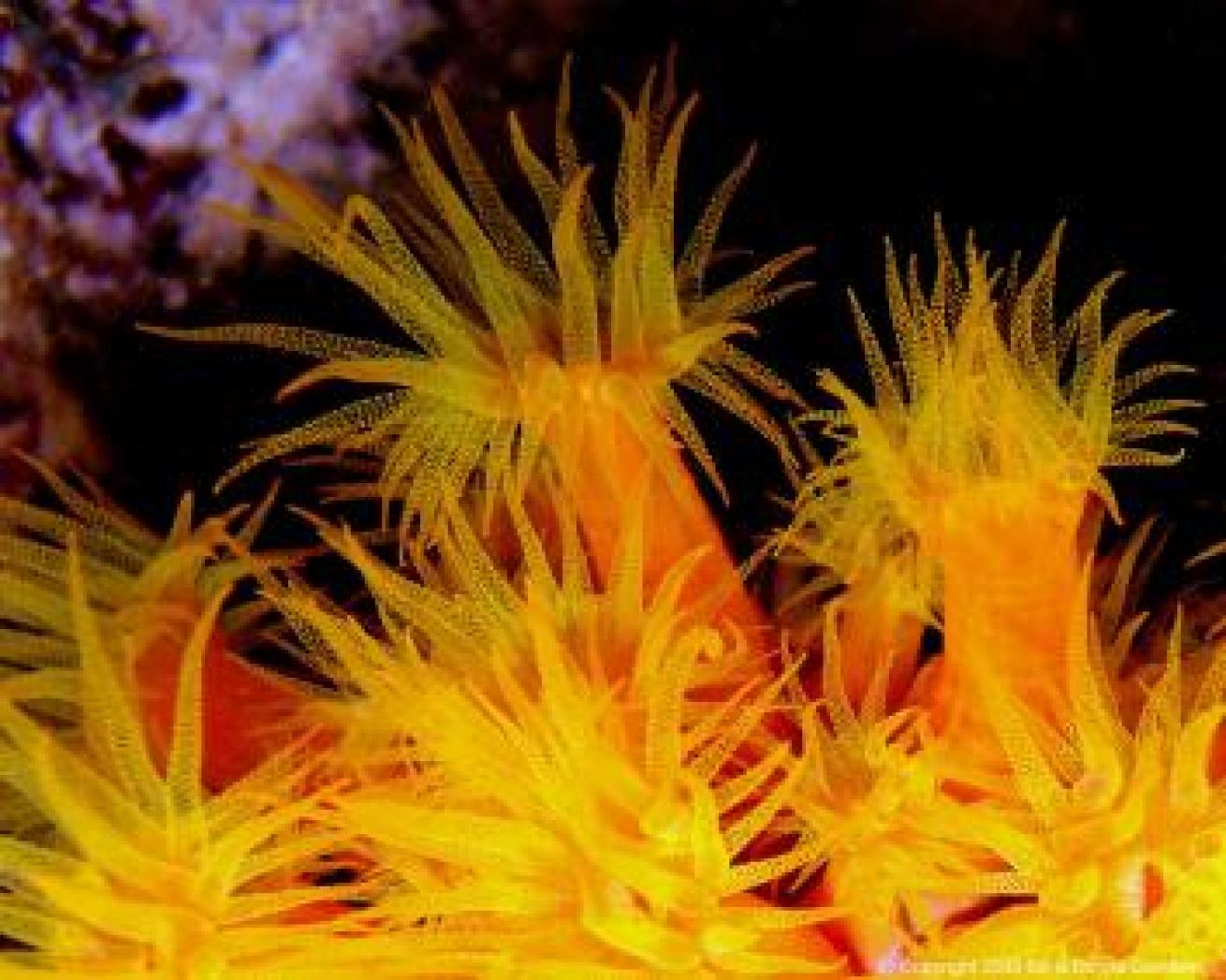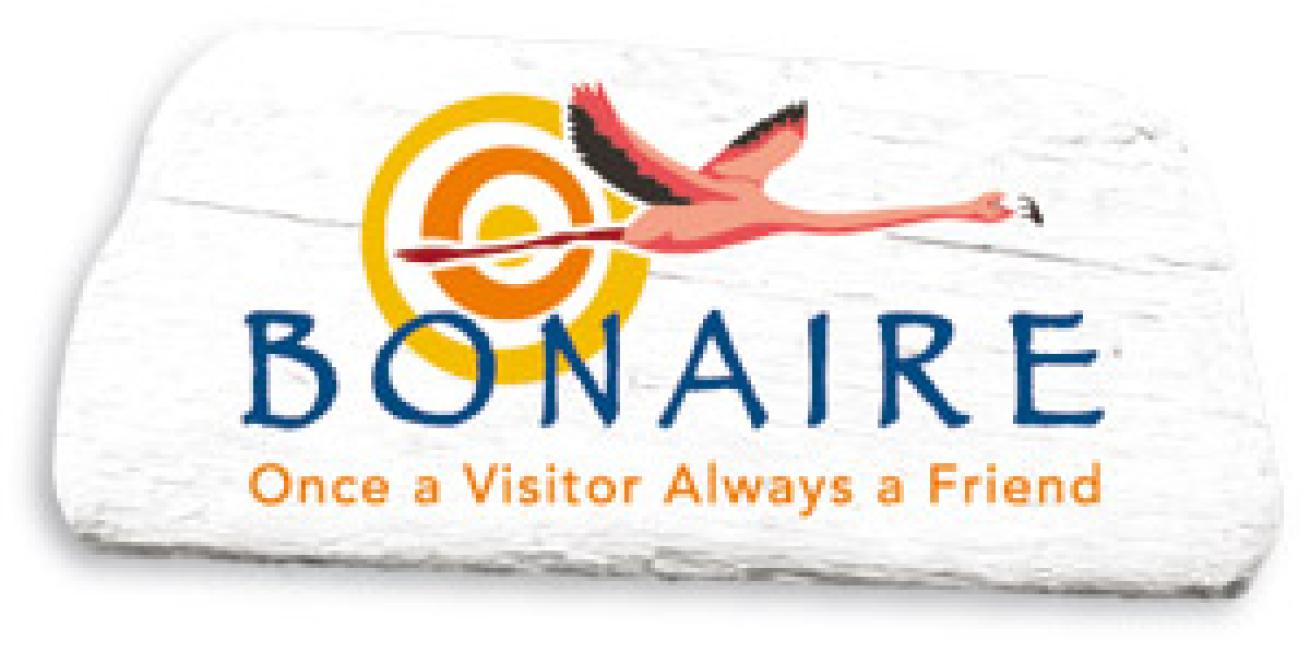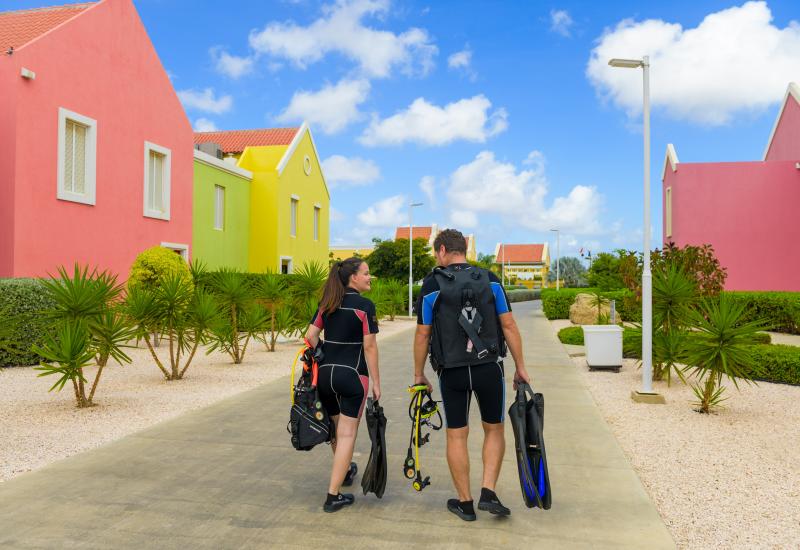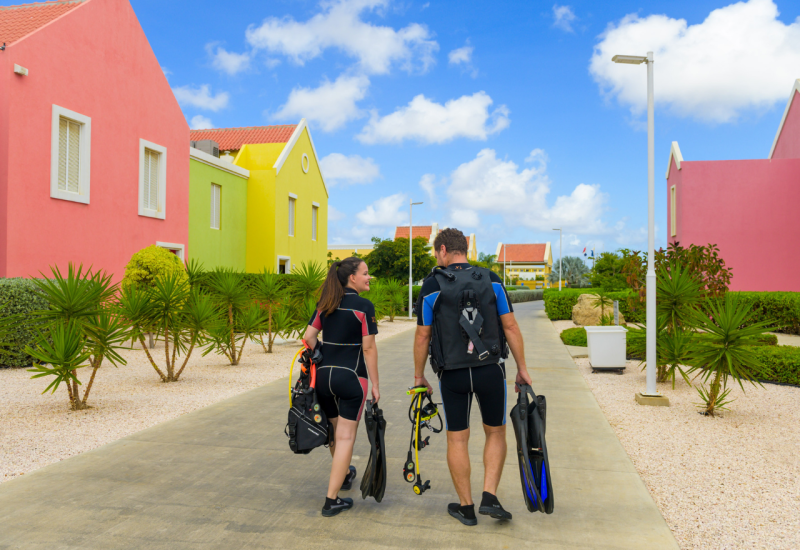Tourism Corp of Bonaire - Diving

Tourism Corp of Bonaire Main
BONAIRE, DUTCH CARIBBEAN: A PARADISE FOR DIVERS
The automobile license plates on Bonaire read "A Diver's Paradise," and there's no disputing the accuracy of this slogan. The highly accessible reefs that surround Bonaire are renowned for world-class diving. The island is home to one of the world's top underwater environments for certified and new divers.
Diving 24 Hours a Day, 365 Days a Year
BONAIRE, DUTCH CARIBBEAN: A PARADISE FOR DIVERS
The automobile license plates on Bonaire read "A Diver's Paradise," and there's no disputing the accuracy of this slogan. The highly accessible reefs that surround Bonaire are renowned for world-class diving. The island is home to one of the world's top underwater environments for certified and new divers.
Diving 24 Hours a Day, 365 Days a Year
Created through volcanic eruptions, the island is an underwater mountain with fringe reefs awaiting right off the beach of every hotel or any part of the island. The average boat trip to dive sites is less than 15-20 minutes, with the farthest reachable within an hour. Bonaire is also known for some of the best short diving in the Caribbean; divers can pick up their tanks, pack up their gear and drive off in search of yellow painted stones positioned all over the island which indicate a shore dive site. With only 12 inches of annual rainfall, water visibility is typically 100 feet or more. And because the sites are close to shore and the water is so calm, visitors can dive anytime, day or night, 365 days a year.
Over 86 Varied Dive Sites
Shaped like a boomerang, Bonaire is only 24 miles long and from three to seven miles wide. Less than a mile off the south coast is the uninhabited Klein Bonaire (Little Bonaire), which acts like a barrier reef, creating calm, leeward waters. The island's north coast, in contrast, is battered by strong waves that pound against the rocky coast.
Amazing reefs are found within the protected leeward side of the island where the reefs have a narrow, sloping terrace extending seaward with a drop-off at 33 feet, followed by a slope varying from 30 feet to a vertical wall of 100 to 200 feet deep. Excellent walk-in dive sites are "Thousand Steps" and further north at "Nukove."
Accessible by boat is "Alice in Wonderland," a double reef complex, separated by a sand channel and extending from Pt. Vierkant south toward Salt Pier. There are a number of good dive sites within this reef system, all marked by dive buoys. "Angel City," one of the most popular, is home to the 1,000-ton freighter "Hilma Hooker," Bonaire's most notorious shipwreck. Twenty-four reef sites with depths of 20 - 130 feet surround Klein Bonaire and all are easily accessible from shore. "Forest" , "Sharon’s Serenity", “Hands Off” and “Keep Sake” are to name a few.
Snorkeling for Non-Divers
All of the attributes that make Bonaire a haven for diving apply to snorkeling. Right from their hotels, snorkelers can wade from the shore to the reefs and view an array of coral, including Elkhorn Barrier, Fire and Leaf corals, and a range of colorful fish, such as Redlip Blennies, Jewelfish and Parrot Fish. The reefs just off Klein Bonaire and Washington-Slagbaai National Park are popular sites for snorkeling too. All island dive shops rent snorkeling equipment and can provide instruction.
History of Environmentally Friendly Policies
With a far-sighted dedication to protecting their assets both under and above the water, the government of Bonaire was environmentally aware long before it became fashionable and Bonaire continues to be recognized as a role model for its sustainable tourism. In 1979 Bonaire designated all surrounding waters as a Marine Park, including a ban on spear fishing and coral collecting within the park, and later instituted permanent moorings to minimize anchor damage. A reef preservation program offers visiting divers free advanced and photo buoyancy control workshops through all island dive shops. As a result of these efforts, Bonaire was designated by the National Oceanic and Atmospheric Administration (NOAA) as having the healthiest reefs in the Caribbean (January 2008), and divers and snorkelers will find the reefs with lush coral growth and over 364 species of fish and abundant fish population.

Bonaire - Logo
Details
Information: Kaya Grandi #2 Kralendijk Bonaire
Phone: 1-800 BONAIRE
Email: [email protected]
Website: www.tourismbonaire.com

BONAIRE, DUTCH CARIBBEAN: A PARADISE FOR DIVERS
The automobile license plates on Bonaire read "A Diver's Paradise," and there's no disputing the accuracy of this slogan. The highly accessible reefs that surround Bonaire are renowned for world-class diving. The island is home to one of the world's top underwater environments for certified and new divers.
Diving 24 Hours a Day, 365 Days a Year
BONAIRE, DUTCH CARIBBEAN: A PARADISE FOR DIVERS
The automobile license plates on Bonaire read "A Diver's Paradise," and there's no disputing the accuracy of this slogan. The highly accessible reefs that surround Bonaire are renowned for world-class diving. The island is home to one of the world's top underwater environments for certified and new divers.
Diving 24 Hours a Day, 365 Days a Year
Created through volcanic eruptions, the island is an underwater mountain with fringe reefs awaiting right off the beach of every hotel or any part of the island. The average boat trip to dive sites is less than 15-20 minutes, with the farthest reachable within an hour. Bonaire is also known for some of the best short diving in the Caribbean; divers can pick up their tanks, pack up their gear and drive off in search of yellow painted stones positioned all over the island which indicate a shore dive site. With only 12 inches of annual rainfall, water visibility is typically 100 feet or more. And because the sites are close to shore and the water is so calm, visitors can dive anytime, day or night, 365 days a year.
Over 86 Varied Dive Sites
Shaped like a boomerang, Bonaire is only 24 miles long and from three to seven miles wide. Less than a mile off the south coast is the uninhabited Klein Bonaire (Little Bonaire), which acts like a barrier reef, creating calm, leeward waters. The island's north coast, in contrast, is battered by strong waves that pound against the rocky coast.
Amazing reefs are found within the protected leeward side of the island where the reefs have a narrow, sloping terrace extending seaward with a drop-off at 33 feet, followed by a slope varying from 30 feet to a vertical wall of 100 to 200 feet deep. Excellent walk-in dive sites are "Thousand Steps" and further north at "Nukove."
Accessible by boat is "Alice in Wonderland," a double reef complex, separated by a sand channel and extending from Pt. Vierkant south toward Salt Pier. There are a number of good dive sites within this reef system, all marked by dive buoys. "Angel City," one of the most popular, is home to the 1,000-ton freighter "Hilma Hooker," Bonaire's most notorious shipwreck. Twenty-four reef sites with depths of 20 - 130 feet surround Klein Bonaire and all are easily accessible from shore. "Forest" , "Sharon’s Serenity", “Hands Off” and “Keep Sake” are to name a few.
Snorkeling for Non-Divers
All of the attributes that make Bonaire a haven for diving apply to snorkeling. Right from their hotels, snorkelers can wade from the shore to the reefs and view an array of coral, including Elkhorn Barrier, Fire and Leaf corals, and a range of colorful fish, such as Redlip Blennies, Jewelfish and Parrot Fish. The reefs just off Klein Bonaire and Washington-Slagbaai National Park are popular sites for snorkeling too. All island dive shops rent snorkeling equipment and can provide instruction.
History of Environmentally Friendly Policies
With a far-sighted dedication to protecting their assets both under and above the water, the government of Bonaire was environmentally aware long before it became fashionable and Bonaire continues to be recognized as a role model for its sustainable tourism. In 1979 Bonaire designated all surrounding waters as a Marine Park, including a ban on spear fishing and coral collecting within the park, and later instituted permanent moorings to minimize anchor damage. A reef preservation program offers visiting divers free advanced and photo buoyancy control workshops through all island dive shops. As a result of these efforts, Bonaire was designated by the National Oceanic and Atmospheric Administration (NOAA) as having the healthiest reefs in the Caribbean (January 2008), and divers and snorkelers will find the reefs with lush coral growth and over 364 species of fish and abundant fish population.

Details
Information: Kaya Grandi #2 Kralendijk Bonaire
Phone: 1-800 BONAIRE
Email: [email protected]
Website: www.tourismbonaire.com










